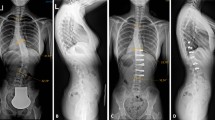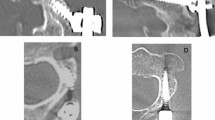Abstract
Summary
We prospectively investigated related clinical and radiological risk factors for progression following acute osteoporotic spinal fractures. Fracture location, morphological feature (mid-portion), and involvement of vertebral posterior wall were statistical significant risk factors considering increase of height loss and kyphotic angle, and occurrence of intravertebral cleft sign as a progressive collapse.
Introduction
This study was designed to investigate the clinical and radiological risk factors related to progressive collapse of acute osteoporotic spinal fractures (OSF).
Methods
In total, 100 patients with acute OSF were prospectively enrolled at a single institute. Five pathological fractures were excluded. Twelve patients dropped out of the study because of conversion to surgical treatment during follow-up. Eight patients were excluded as follow-up losses. Thus, 75 patients were analyzed. Clinical data and radiological data were recorded and analyzed. As a definition of progressive OSF, height loss ≥15 %, kyphotic angle ≥10°, and the occurrence of an intravertebral cleft sign at the 6-month follow-up compared to the initial values were adopted. Correlation analysis and multiple logistic regression analyses were performed to elucidate the related clinical or radiological factors for progressive OSF.
Results
The occurrence of intravertebral cleft was not related to any significant differences in the clinical results and was only related to the fracture level in the regression analysis. A ≥15 % increase in height loss and a ≥10° increase in kyphotic angle were related to worse clinical results. Mid-portion type fractures and involvement of the posterior wall were significant risk factors with relatively high odds ratios for progressive OSF under these criteria.
Conclusion
A thoracolumbar fracture, a mid-portion type fracture, and involvement of the vertebral posterior wall are relative risk factors for progressive collapse following acute OSF. More attention should be paid to patients with OSF and these risk factors during conservative management.




Similar content being viewed by others
References
Johnell O, Kanis J (2005) Epidemiology of osteoporotic fractures. Osteoporosis Int 16(Suppl):S3–S7
Kutsal YG, Atalay A, Arslan S et al (2005) Awareness of osteoporotic patients. Osteoporosis Int 16:128–133
Cummings SR, Melton LJ (2002) Epidemiology and outcomes of osteoporotic fractures. Lancet 359:1761–1767
Klazen C, Verhaar H, Lampmann L et al (2007) VERTOS II: percutaneous vertebroplasty versus conservative therapy in patients with painful osteoporotic vertebral compression fractures; rationale, objectives and design of a multicenter radomized controlled trial. Trials 8:33
Boonen S, Wahl DA, Nauroy L, Brandi ML et al (2011) Balloon kyphoplasty and vertebroplasty in the management of vertebral compression fractures. Osteoporosis Int 22:2915–2934
Ha KY, Lee JS, Kim KW, Chon JS (2006) Percutaneous vertebroplasty for vertebral compression fractures with and without intravertebral clefts. J Bone Joint Surg Br 88:629–633
Kempinsky WH, Morgan PP, Boniface WR (1958) Osteoporotic kyphosis with paraplegia. Neurol 8:181–186
Baba H, Maezawa Y, Kamitani K, Furusawa N, Imura S, Tomita K (1995) Osteoporotic vertebral collapse with late neurological complications. Paraplegia 33:281–289
Hasegawa K, Homma T, Uchiyama S, Takahashi H (1998) Vertebral pseudarthrosis in the osteoporotic spine. Spine (Phila Pa 1976) 23:2201–2206
Ito Y, Hasegawa Y, Toda K, Nakahara S (2002) Pathogenesis and diagnosis of delayed vertebral collapse resulting from osteoporotic spinal fracture. Spine J 2:101–106
Libicher M, Appelt A, Berger I et al (2007) The intravertebral vacuum phenomen as specific sign of osteonecrosis in vertebral compression fractures: results from a radiological and histological study. Eur Radiol 17:2248–2252
Yu CW, Hsu CY, Shih TT, Chen BB, Fu CJ (2007) Vertebral osteonecrosis: MR imaging findings and related changes on adjacent levels. AJNR Ame J Neuroradiol 28:42–47
Wang G, Yang H, Chen K (2010) Osteoporotic vertebral compression fractures with an intravertebral cleft treated by percutaneous balloon kyphoplasty. J Bone Joint Surg Br 92:1553–1557
Sugita M, Watanabe N, Mikami Y, Hase H, Kubo T (2005) Classification of vertebral compression fractures in the osteoporotic spine. J Spinal Disord Tech 18:376–381
McKiernan F, Jensen R, Faciszewski T (2003) The dynamic mobility of vertebral compression fractures. J Bone Miner Res 18:24–29
Ha KY, Kim KW, Kim YH, Oh IS, Park SW (2010) Revision surgery after vertebroplasty or kyphoplasty. Clin Orthop Surg 2:203–208
Sohn JM, Kim KW, Ha KY, Ha NK, Kim YH, Kim JH (2009) Risk factors for the progressive osteoporotic spinal fracture. J Korean Soc Spine Surg 16:153–159
Tsujio T, Nakamura H, Terai H et al (2011) Characteristic radiographic or magnetic resonance images of fresh osteoporotic vertebral fractures predicting potential risk for nonunion: a prospective multicenter study. Spine (Phila Pa 1976) 36:1229–1235
Hoshino M, Nakamura H, Terai H et al (2009) Factors affecting neurological deficits and intractable back pain in patients with insufficient bone union following osteoporotic vertebral fracture. Eur Spine J 18:1279–1286
Suk SI, Kim JH, Lee SM, Chung ER, Lee JH (2003) Anterior-posterior surgery versus posterior closing wedge osteotomy in post-traumatic kyphosis with neurologic compromised osteoporotic fracture. Spine (Phila Pa 1976) 28:2170–5
Sudo H, Ito M, Abumi K et al (2010) One-stage posterior instrumentation surgery for the treatment of osteoporotic vertebral collapse with neurologic deficits. Eur Spine J 19:907–15
Genant HK, Wu CY, Kuijk CV, Nevitt MC (1993) Vertebral fracture assessment using a semiquantitative technique. J Bone Miner Res 8:1137–48
Grados F, Fechtenbaum J, Flipon E, Kolta S, Roux C, Fardellone P (2009) Radiographic methods for evaluating osteoporotic vertebral fractures. Joint Bone Spine 76:241–7
Acknowledgments
We would like to express special thanks to Dr. Kim Hyun-Woo and Dr. Lee Ju-Yup for their contribution to clinical data preparation. This study is partially supported by research grant of Dae-woong Pharmacy Co. No other funds or benefits in any form have been or will be received from a commercial party related directly or indirectly to the subject of this study.
Conflicts of interest
This study is partially supported by research grant of Dae-woong Pharmacy Co.
Author information
Authors and Affiliations
Corresponding author
Rights and permissions
About this article
Cite this article
Ha, K.Y., Kim, Y.H. Risk factors affecting progressive collapse of acute osteoporotic spinal fractures. Osteoporos Int 24, 1207–1213 (2013). https://doi.org/10.1007/s00198-012-2065-z
Received:
Accepted:
Published:
Issue Date:
DOI: https://doi.org/10.1007/s00198-012-2065-z




